
Alkynes Based on McMurry's Organic Chemistry,6th edition,Chapter 8
Alkynes Based on McMurry’s Organic Chemistry, 6th edition, Chapter 8
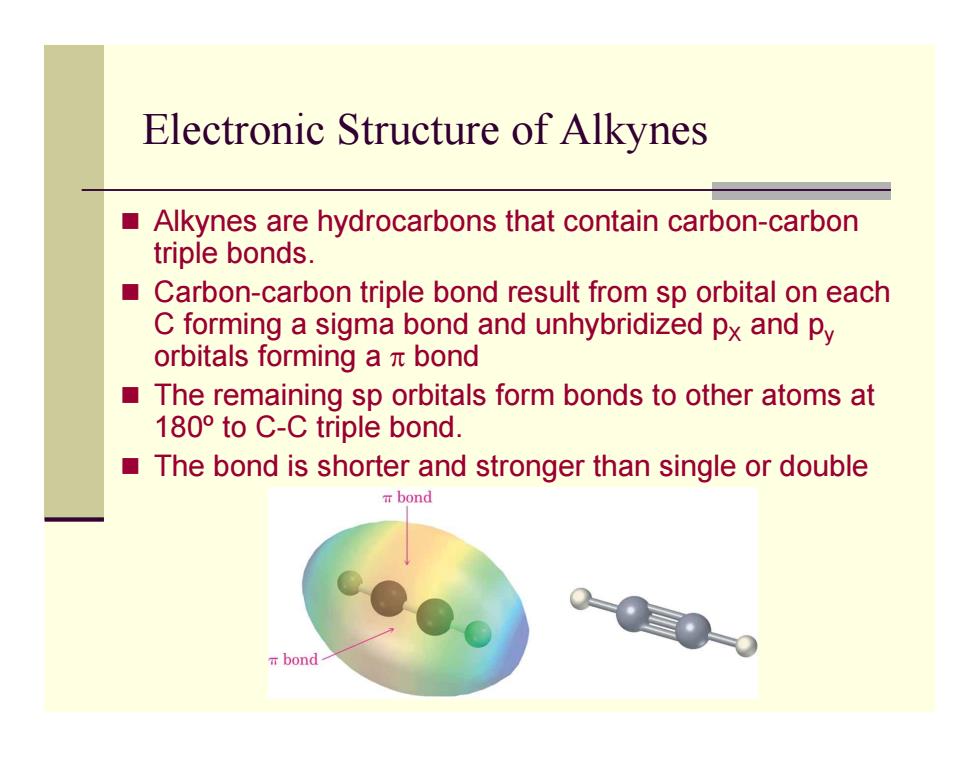
Electronic Structure of Alkynes Alkynes are hydrocarbons that contain carbon-carbon triple bonds. ■ Carbon-carbon triple bond result from sp orbital on each C forming a sigma bond and unhybridized px and py orbitals forming a t bond The remaining sp orbitals form bonds to other atoms at 180 to C-C triple bond. The bond is shorter and stronger than single or double T bond m bond
Electronic Structure of Alkynes Alkynes are hydrocarbons that contain carbon-carbon triple bonds. Carbon-carbon triple bond result from sp orbital on each C forming a sigma bond and unhybridized p X and p y orbitals forming a π bond The remaining sp orbitals form bonds to other atoms at 180º to C-C triple bond. The bond is shorter and stronger than single or double
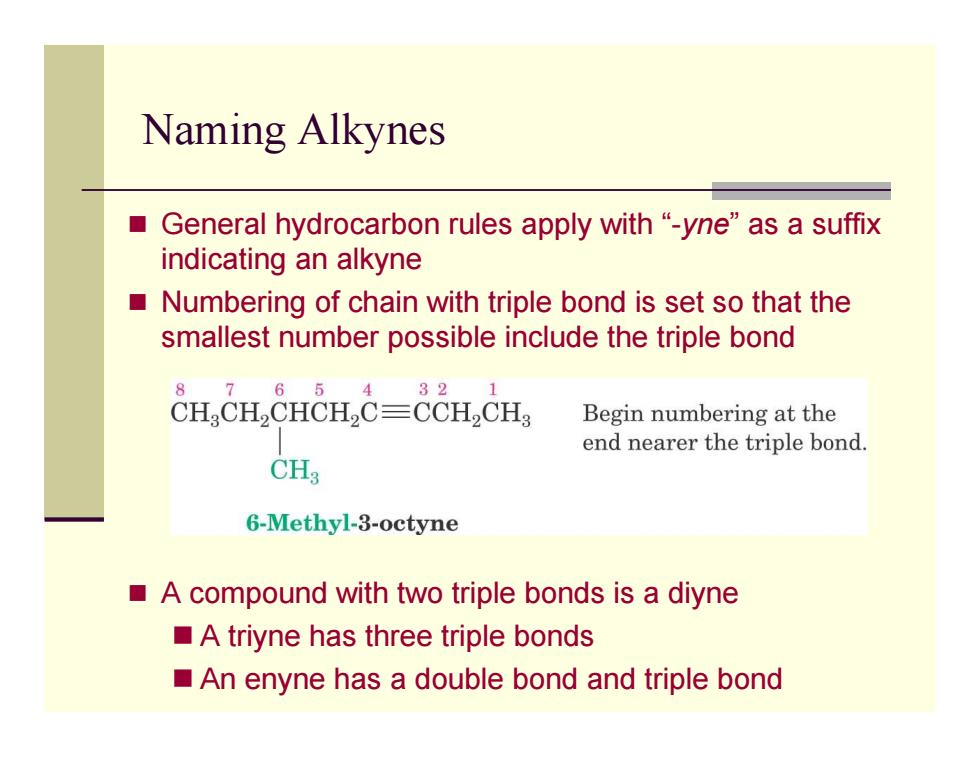
Naming Alkynes ■ General hydrocarbon rules apply with "-yne"as a suffix indicating an alkyne ■ Numbering of chain with triple bond is set so that the smallest number possible include the triple bond 8 7 65 432 CH CHCHCH2C=CCH2CH Begin numbering at the end nearer the triple bond. CHg 6-Methyl-3-octyne A compound with two triple bonds is a diyne A triyne has three triple bonds An enyne has a double bond and triple bond
Naming Alkynes General hydrocarbon rules apply with “-yne” as a suffix indicating an alkyne Numbering of chain with triple bond is set so that the smallest number possible include the triple bond A compound with two triple bonds is a diyne A triyne has three triple bonds An enyne has a double bond and triple bond
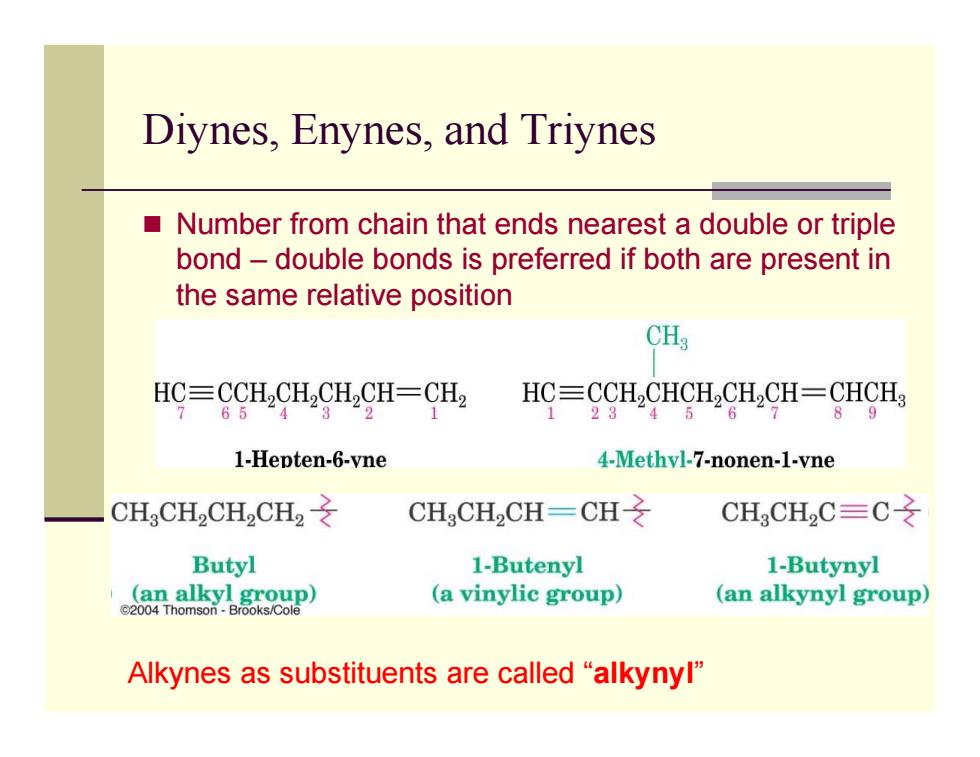
Diynes,Enynes,and Triynes Number from chain that ends nearest a double or triple bond-double bonds is preferred if both are present in the same relative position CH3 HC三CCH2CHCH2CH=CH2 HC=CCH,CHCH2CH2CH=CHCH3 65 3 2 1 23 45 89 1-Hepten-6-vne 4-Methvl-7-nonen-1-vne CHCH2CH2CH2之 CH CH2CH-CH CH3CH2C=C之 Butyl 1-Butenyl 1-Butynyl 4aal黑e (a vinylic group) (an alkynyl group) Alkynes as substituents are called "alkynyl
Diynes, Enynes, and Triynes Number from chain that ends nearest a double or triple bond – double bonds is preferred if both are present in the same relative position Alkynes as substituents are called “alkynyl
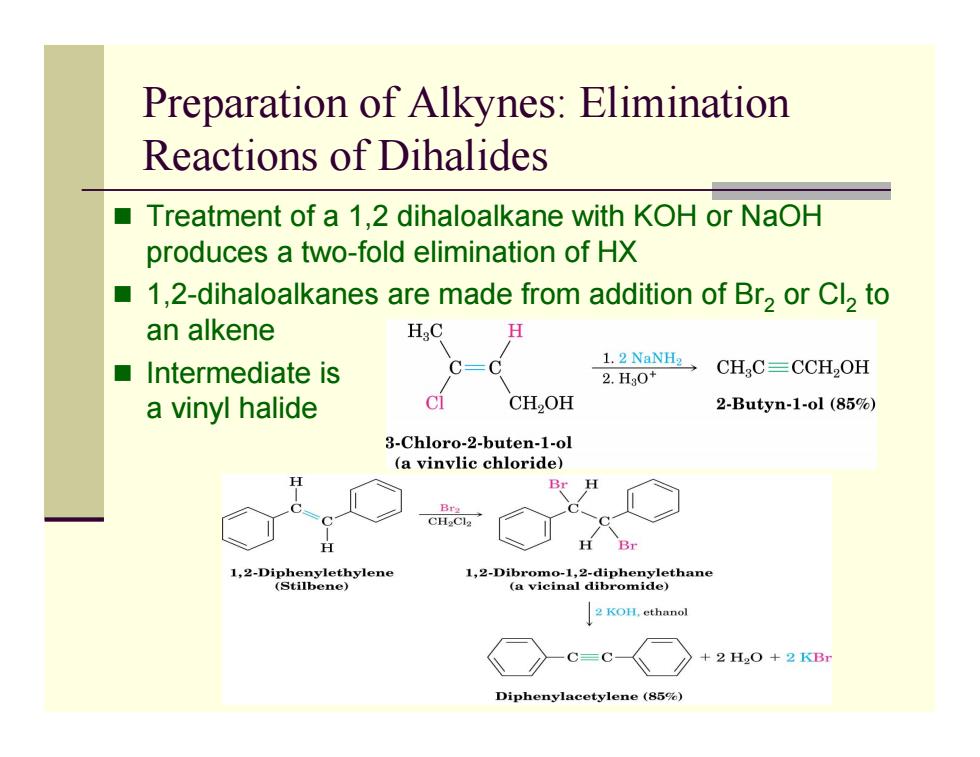
Preparation of Alkynes:Elimination Reactions of Dihalides ■ Treatment of a 1,2 dihaloalkane with KOH or NaOH produces a two-fold elimination of HX ■ 1,2-dihaloalkanes are made from addition of Br2 or Cl2 to an alkene HC ■Intermediate is 1.2 NaNH2 2.Hg0+ CHC=CCH,OH a vinyl halide C CH2OH 2-Butyn-1-ol (85%) 3-Chloro-2-buten-1-ol (a vinvlic chloride) Br H B型 1,2-Diphenylethylene (Stilbene) 1-Dticina)thane 2 KOH,ethanol C=C- +2H2O+2B Diphenylacetylene(85%)
Preparation of Alkynes: Elimination Reactions of Dihalides Treatment of a 1,2 dihaloalkane with KOH or NaOH produces a two-fold elimination of HX 1,2-dihaloalkanes are made from addition of Br 2 or Cl 2 to an alkene Intermediate is a vinyl halide
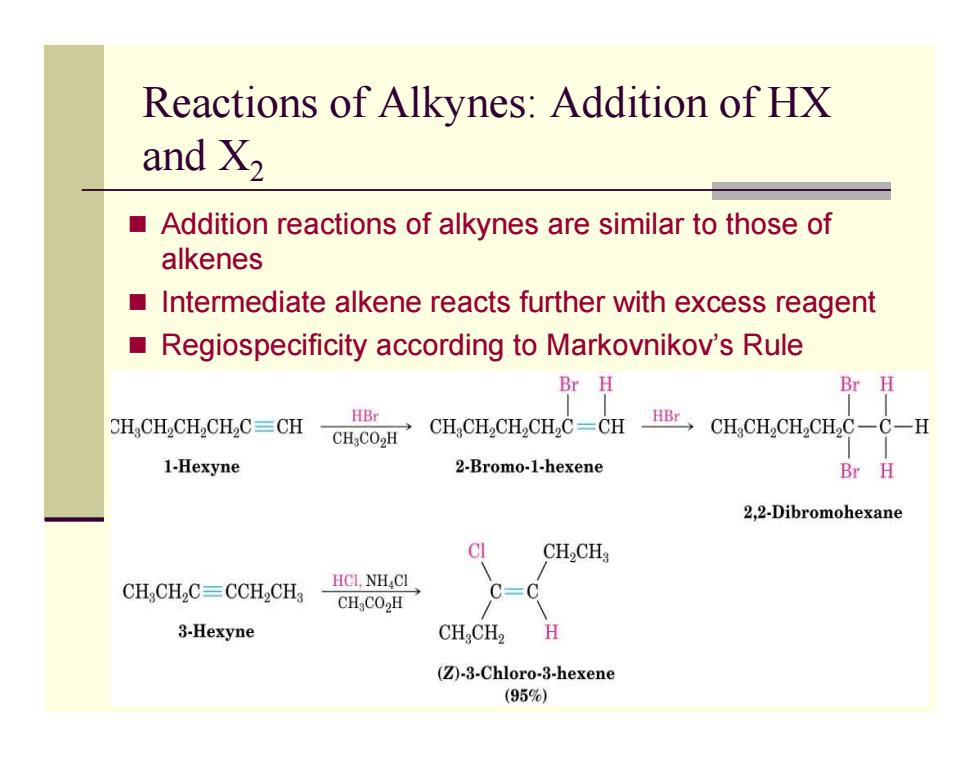
Reactions of Alkynes:Addition of HX and X2 Addition reactions of alkynes are similar to those of alkenes Intermediate alkene reacts further with excess reagent Regiospecificity according to Markovnikov's Rule Br H Br H CH CHCH2CH2C=CH HBr CH2CO2H CH CH2CH2CH,C=CH HBr CH CH2CH2CH2C-C-H 1-Hexyne 2-Bromo-1-hexene Br H 2,2-Dibromohexane CH,CH CH CH2C=CCH2CH HCI.NH CI C=C CH3CO2H 3-Hexyne CH,CH2 H (Z)-3-Chloro-3-hexene (95%)
Reactions of Alkynes: Addition of HX and X 2 Addition reactions of alkynes are similar to those of alkenes Intermediate alkene reacts further with excess reagent Regiospecificity according to Markovnikov’s Rule
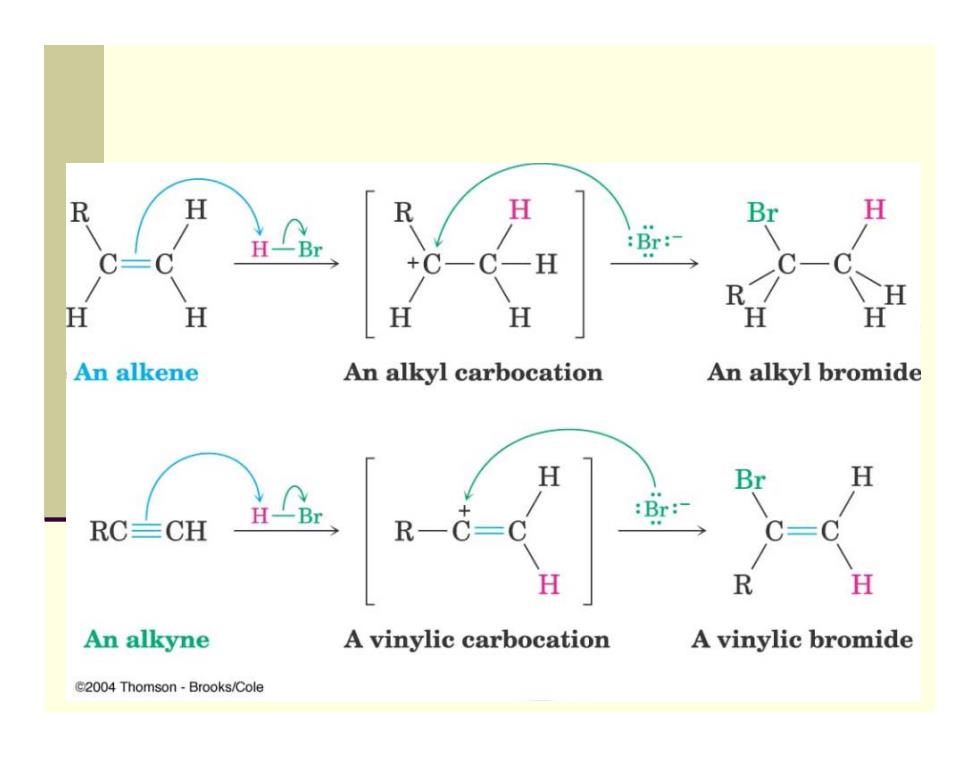
R R H Br H-Br :Br:- +0 H H H An alkene An alkyl carbocation An alkyl bromide H Br H :Br: RC=CH R一 H R H An alkyne A vinylic carbocation A vinylic bromide 2004 Thomson-Brooks/Cole

Addition of Bromine and Chlorine ■ Initial addition gives trans intermediate In the presence of excess reagent,a tetrahalide is obtained CHCH2 Br CH CH2C=CH Br2 Br2 CH2Cl2 CH2Cl2 CHCH2CBr2CHBr2 1-Butyne Br H 1,1,2,2-Tetrabromobutane (E)-1.2-Dibromo-1-butene
Addition of Bromine and Chlorine Initial addition gives trans intermediate In the presence of excess reagent, a tetrahalide is obtained
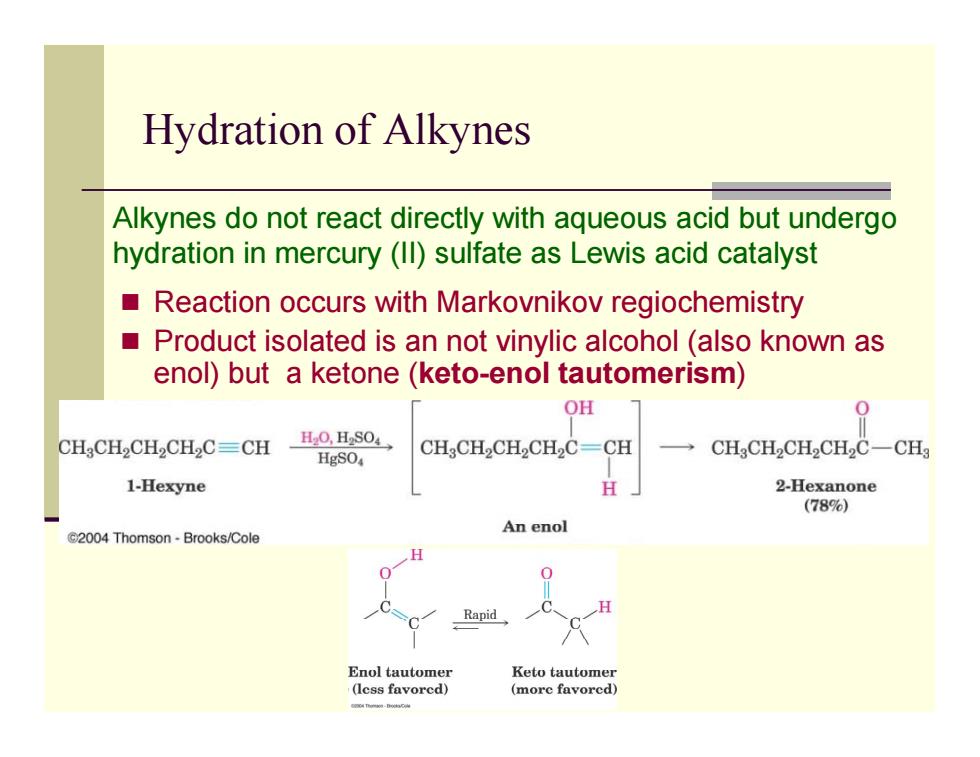
Hydration of Alkynes Alkynes do not react directly with aqueous acid but undergo hydration in mercury(Il)sulfate as Lewis acid catalyst Reaction occurs with Markovnikov regiochemistry Product isolated is an not vinylic alcohol (also known as enol)but a ketone(keto-enol tautomerism) OH CHCH2CH2CH2C=CH H2O,H2SO4 CHCH2CH2CH2C-CH HgsO4 CHgCH2CH2CH2C-CHg 1-Hexyne H 2-Hexanone (786) An enol C2004 Thomson-Brooks/Cole H 0 Rapid H Enol tautomer Keto tautomer (Icss favorcd) (more favorcd) Toe-Dhoek
Reaction occurs with Markovnikov regiochemistry Product isolated is an not vinylic alcohol (also known as enol) but a ketone (keto-enol tautomerism) Hydration of Alkynes Alkynes do not react directly with aqueous acid but undergo hydration in mercury (II) sulfate as Lewis acid catalyst

Mechanism of Mercury(ID)-Catalyzed Hydration of Alkynes The alkyne uses a pair of electrons to R一C attack the electrophilic mercury(I) Hg2+802 ion,yielding a mercury-containing ■ Electrophilic vinylie carbocation intermediate. addition of Hg(Il)to Nucleophilic attack of water on Hg'SO alkyne gives a the earbocation forms a C-O bond and yields a protonated mercury- vinylic cation containing enol. ■Vater adds and Hg+802 loses a proton ■Acidic reaction +HO condition is e olacement of Hg'by H'occurs sufficient to replace to give a neutral enol mercury by H +HO The enol under to give e the final ketone product
Mechanism of Mercury(II)-Catalyzed Hydration of Alkynes Electrophilic addition of Hg(II) to alkyne gives a vinylic cation Water adds and loses a proton Acidic reaction condition is sufficient to replace mercury by H